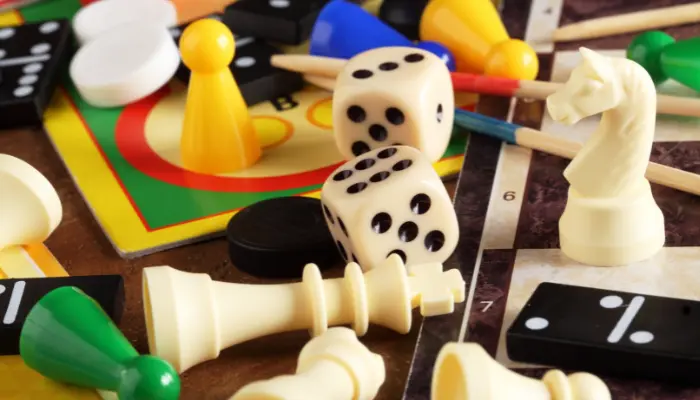Welcome to TrueBuddy
Thank you for visiting my blog on “Indoor Games for All Ages“. I have dedicated a considerable amount of time to researching and compiling this comprehensive guide to help you make an informed decision.
In this blog post, You will read:
- Benefits of Indoor Games
- Choosing the Right Indoor Game
- How Indoor Games Can Improve Social Skills and Communication
- Top 10 Indoor Games for Family
- FAQs on Indoor Games
If you plan to buy any products, kindly click through my link. I may receive a small commission from the purchase you make without costing you any extra penny.
This commission will help and encourage me to write some more useful articles.
Don’t Forget to Check Out Some of the Best Deals of the Day on Amazon.
Indoor games offer a fantastic way to engage, entertain, and bond with family and friends, regardless of age. Whether it’s a rainy day, a family gathering, or a cozy evening at home, having a repertoire of enjoyable indoor games is essential. In this comprehensive guide, we will explore a wide range of indoor games suitable for all ages and interests. From classic board games to active and educational games, there is something for everyone. So, gather around, and let’s dive into the ultimate guide to the best indoor games for all ages.
You may also like:
Benefits of Indoor Games

Indoor games offer more than just entertainment and fun. Engaging in these games provides a range of benefits that contribute to personal growth, cognitive development, social interaction, and overall well-being. Here are some key benefits of playing indoor games:
1. Cognitive Development
Indoor games stimulate cognitive abilities and mental processes. Whether it’s strategizing in a board game or solving puzzles, these activities enhance critical thinking, problem-solving skills, memory retention, and decision-making abilities. Engaging in indoor games regularly can improve cognitive function and promote intellectual development.
2. Social Interaction and Bonding
Indoor games provide opportunities for social interaction and bonding with family, friends, or fellow players. Whether playing cooperatively or competitively, these games foster communication, teamwork, and collaboration. They create shared experiences, strengthen relationships, and promote a sense of belonging and connection.
3. Stress Relief and Relaxation
Playing indoor games can be a great way to unwind and relieve stress. Engaging in enjoyable activities stimulates the release of endorphins, which are natural mood-boosting hormones. Games provide a temporary escape from daily worries and responsibilities, allowing individuals to relax, have fun, and rejuvenate their minds.
4. Enhanced Motor Skills and Coordination
Many indoor games require physical movements and coordination, such as throwing, catching, or moving game pieces. These activities improve motor skills, hand-eye coordination, and fine motor control. Whether it’s playing a video game or participating in a physical game, individuals can enhance their motor skills through regular gameplay.
5. Creativity and Imagination
Certain indoor games, such as role-playing or creative games, encourage imagination and creativity. They allow individuals to express themselves, think outside the box, and explore new ideas and possibilities. Such games foster innovation, problem-solving, and the development of imaginative thinking skills.
6. Learning and Educational Value
Many indoor games have educational components that make learning enjoyable. They can teach various math, language, history, or science subjects through interactive gameplay. Educational games promote learning in a fun and engaging way, making complex concepts easier to grasp and retain.
7. Improved Focus and Concentration
Playing indoor games requires focus, attention, and concentration. Whether it’s keeping track of game rules, strategizing, or making split-second decisions, individuals develop and enhance their ability to concentrate on tasks. Regular gameplay can improve concentration skills and transfer to other areas of life.
8. Adaptability and Resilience
Indoor games often present challenges, setbacks, and unforeseen circumstances that require adaptability and resilience. Players learn to adjust their strategies, handle unexpected situations, and bounce back from setbacks. These games teach individuals to be flexible, adaptive, and resilient in the face of changing circumstances.
Choosing the Right Indoor Game

When it comes to games for inside the house, there is a wide array of options available to suit different interests and preferences. Choosing the right indoor game is essential to ensure an enjoyable and engaging experience. Whether you’re playing alone, with a partner, or in a group, here are some key factors to consider when selecting the perfect indoor game for your enjoyment.
1. Consider the Number of Players
First and foremost, consider the number of players who will be participating in the game. Some games are designed for solo play, while others require a minimum number of players or are more enjoyable with a larger group. Take into account the number of people available to play and choose a game that accommodates the group size.
2. Determine the Age Group and Skill Level
Indoor games are often designed with specific age groups and skill levels in mind. Consider the ages and abilities of the players involved. For children, look for games that are age-appropriate and offer a suitable level of challenge. Likewise, for adults or more experienced players, seek games that provide a higher level of complexity or strategic depth.
3. Identify Interests and Preferences
Take into account the interests and preferences of the players. Some individuals may enjoy competitive games that test their skills and offer intense gameplay, while others may prefer cooperative games that promote teamwork and collaboration. Consider whether players enjoy games that involve strategy, problem-solving, trivia, creativity, or physical activity, and choose a game that aligns with their interests.
4. Assess Available Time
Consider the amount of time available for gameplay. Some indoor games can be completed within a short duration, while others may require a more significant time commitment. If you have limited time available, opt for games that can be played in shorter sessions or have flexible playtime options.
5. Consider Available Space and Resources
Take into account the space and resources available for the game. Some games may require a large playing area or specific equipment, while others can be played in a smaller space with minimal requirements. Ensure that you have enough room and the necessary resources to play the game comfortably.
6. Read Reviews and Recommendations
Before making a final decision, read reviews and seek recommendations from reliable sources. Online reviews, gaming forums, and recommendations from friends or family members can provide valuable insights into the gameplay experience, mechanics, and overall enjoyment of a particular indoor game.
7. Try Out Different Games
Don’t be afraid to try out different games to find what suits your preferences. Borrow games from friends, visit board game cafes, or explore digital platforms that offer a variety of indoor games. Experimenting with different games allows you to discover new favorites and expand your gaming repertoire.
How Indoor Games Can Improve Social Skills and Communication

Indoor games are not only a source of entertainment but also serve as valuable tools for improving social skills and communication. Engaging in these games provides opportunities for interaction, cooperation, and the development of essential interpersonal abilities. Whether it’s playing a board game with family or participating in a multiplayer video game with friends, here’s how indoor games can enhance social skills and communication.
1. Promoting Cooperation and Teamwork
Many indoor games require teamwork and cooperation to achieve a common goal. Whether it’s working together to solve a puzzle, strategizing as a team in a board game, or coordinating actions in a multiplayer video game, players learn the importance of collaboration. By communicating effectively, sharing ideas, and supporting each other, individuals develop valuable teamwork and cooperation skills that are applicable in various real-life scenarios.
2. Encouraging Communication and Expression
Indoor games create an environment that encourages communication and self-expression. During gameplay, participants share thoughts, discuss strategies, and express their ideas and opinions. This active engagement fosters effective communication skills, including active listening, expressing thoughts clearly, and understanding different perspectives. Through conversations and discussions that arise during gameplay, players learn to articulate their ideas and engage in meaningful interactions.
3. Enhancing Problem-Solving and Decision-Making Abilities
Indoor games often present challenges that require problem-solving and decision-making skills. Players must analyze situations, evaluate options, and make choices that will impact the outcome of the game. Engaging in these activities enhances critical thinking abilities, logical reasoning, and the ability to make informed decisions. Moreover, collaborating with others during problem-solving exercises develops the skill of considering diverse viewpoints and finding creative solutions as a team.
4. Building Empathy and Understanding
Indoor games allow individuals to step into different roles, experience diverse perspectives, and develop empathy. Role-playing games, for instance, allow players to immerse themselves in fictional characters, understand their motivations, and interact with others accordingly. By exploring these roles and engaging in cooperative play, individuals develop empathy, understanding, and respect for other’s feelings and perspectives.
5. Nurturing Sportsmanship and Fair Play
Indoor games offer valuable lessons in sportsmanship and fair play. Players learn to respect rules, follow guidelines, and accept both victory and defeat graciously. Through gameplay, individuals develop resilience, patience, and the ability to handle both success and failure with grace. These qualities contribute to healthy competition and create a positive social environment where individuals learn to celebrate others’ achievements and support each other.
Top 10 Indoor Games for Family
Spending quality time with family is a precious and enjoyable experience. Indoor games provide the perfect opportunity for family members of all ages to bond, have fun, and create lasting memories. Here is the list of indoor games that are perfect for family gatherings:
1. Charades

Charades is a classic game that guarantees laughter and entertainment for the whole family. It involves acting out words, phrases, or movie titles without speaking while others try to guess the correct answer. Players have to use gestures, facial expressions, and body movements to convey the clue. Charades encourage creativity, communication, and teamwork as family members work together to decipher the clues and guess the answers. It’s a game that sparks joy, encourages laughter, and creates hilarious moments that will be cherished for years to come.
2. Pictionary

Unleash your artistic talents with Pictionary. This game challenges players to draw clues on a whiteboard or paper while family members try to guess the word or phrase being illustrated. Pictionary tests creativity, drawing skills, and quick thinking. It’s a game that brings out everyone’s competitive spirit as they race against the clock to accurately interpret and depict the clues. Pictionary is not only fun but also encourages communication, imagination, and friendly competition within the family.
3. Twister

Get active and flexible with Twister, a game that guarantees laughter-filled moments for the whole family. Players spin a wheel to determine which hand or foot to place on which colored circle on a mat. As the game progresses, family members twist and stretch their bodies to maintain their balance, often resulting in hilarious contortions and comical situations. Twister promotes physical activity, balance, coordination, and friendly competition. It’s a fantastic game that gets everyone moving, laughing, and enjoying quality time together.
4. Scavenger Hunt

Create an exciting adventure with an indoor scavenger hunt. Family members work together to follow a series of clues hidden throughout the house, leading them to the final treasure. Scavenger hunts encourage teamwork, problem-solving, and critical thinking. They promote collaboration and communication among family members as they strategize, decipher clues, and search for hidden objects. The thrill of discovery and the shared excitement of finding the treasure make scavenger hunts an engaging and memorable activity for the whole family.
5. Uno

Uno is a fast-paced card game that’s easy to learn and enjoyable for all ages. Players take turns matching numbers, colors, or special action cards to get rid of all their cards. Uno is a perfect indoor game for 6 12 year olds as it provides friendly competition, strategic thinking, and opportunities for laughter and excitement. The game tests players’ observation skills and decision-making abilities as they strategize to outsmart their opponents. Uno is a timeless game that brings families together and guarantees endless hours of fun and entertainment.
6. Indoor Bowling

Transform your living room into a bowling alley with indoor bowling. Set up soft bowling pins and use a lightweight ball to create your own mini bowling game. Indoor bowling provides a fun and safe way for the whole family to enjoy the thrill of bowling right at home. It encourages friendly competition, hand-eye coordination, and aiming skills. Players take turns rolling the ball and trying to knock down the pins, cheering each other on and celebrating strikes and spares. Indoor bowling is a fantastic activity that combines physical movement, skill, and family bonding.
7. Board Game Night

Dedicate a night to board games and let everyone choose their favorite game. Whether it’s Monopoly, Scrabble, Clue, or any other classic board game, enjoy friendly competition and quality time together. Board games offer a wide range of options for family fun and engagement. Monopoly allows players to become real estate tycoons, buying and selling properties while negotiating and making strategic decisions. Scrabble challenges vocabulary and spelling skills as players form words on the board. Clue puts family detectives to work, solving a mystery by gathering clues and deducing the culprit, location, and weapon.
These indoor party games foster healthy competition, critical thinking, problem-solving, and strategic planning. Board game nights create opportunities for bonding, friendly rivalry, and creating lasting memories together as a family.
8. Indoor Mini Golf

Create a mini golf course inside your home using household objects. Set up obstacles, tunnels, ramps, and holes using cushions, books, and other items. Indoor mini-golf is a creative and fun way to enjoy a game of golf with the whole family. It challenges players to navigate through the obstacles, demonstrating precision, hand-eye coordination, and patience. Each family member can design their own mini golf hole, adding a personal touch to the course. Indoor mini golf encourages creativity, problem-solving, and friendly competition, providing an entertaining and enjoyable activity for the entire family.
9. Memory Game

Test your memory skills with a classic memory game. Place pairs of cards face down and take turns flipping them over to find matching pairs. Memory games challenge players’ ability to concentrate, remember patterns, and recall information. It’s an activity that promotes cognitive development, memory retention, and focus. Memory games can be customized to suit different age groups, making them suitable for young children and adults alike. Playing together as a family enhances social interaction, and friendly competition, and creates opportunities for laughter and celebration.
10. Karaoke Night

Host a karaoke night and let everyone showcase their singing talents. Sing along to favorite songs using a karaoke machine or smartphone app. Karaoke nights create a lively and entertaining atmosphere where family members can unleash their inner performers and enjoy the joy of singing together. It encourages self-expression, confidence, and creativity. Karaoke nights provide opportunities for laughter, applause, and memorable performances that will be cherished for years to come. This indoor party game is a fantastic activity that brings out the fun-loving side of the family and creates a festive and enjoyable atmosphere.
These top 10 indoor games for family gatherings offer a diverse range of options that cater to different interests and age groups. Whether you’re acting out clues, drawing, twisting, or singing, these games provide endless fun, laughter, and opportunities for bonding.
5 Traditional Indoor Games in India That are Still Very Popular

India has a rich cultural heritage with traditional indoor games that have stood the test of time. Here are five popular traditional indoor games in India:
1. Carrom Board

A beloved tabletop game played on a square board with pockets, Carrom board game involves flicking disks into the pockets using a striker. It requires skill, strategy, and precision, making it a favorite among both young and old.
2. Ludo

Ludo is a classic dice-based board game that has been enjoyed for generations. Players race their tokens around the board, aiming to be the first to reach the finish line. It’s a game that brings families and friends together for hours of laughter and friendly competition.
3. Snakes and Ladders
Snakes and Ladders is a game of chance that traces its origins back to ancient India. Players roll dice and move their markers along the numbered squares, encountering ladders that boost progress and snakes that send them back. It’s a game that teaches patience, counting, and the ups and downs of life.
4. Pachisi

Pachisi is an ancient game that has inspired variations like Ludo and Parcheesi. It is played on a cross-shaped board and involves moving pieces around the board based on the roll of dice. The game requires strategy and anticipation, and it’s a wonderful way to connect with Indian traditions.
5. Antakshari
Antakshari is a popular musical game enjoyed by people of all ages. Players take turns singing songs that start with the last letter of the previous song. It’s a lively and interactive game that showcases Indian music and encourages participants to showcase their singing skills.
Indoor Games: Frequently Asked Questions
Are indoor games suitable for all ages?
Yes, indoor games can be enjoyed by people of all ages. There are age-appropriate games available for toddlers, kids, teens, adults, and seniors. It’s important to choose games that match the participants’ interests, abilities, and developmental stages.
How can indoor games benefit mental health?
Indoor games stimulate cognitive abilities, problem-solving skills, and memory retention. They also provide opportunities for social interaction and bonding, which can enhance mental well-being and reduce stress.
What are some popular educational indoor games?
Popular educational indoor games include math puzzles, science experiments, language learning games, and history trivia quizzes. These games make learning enjoyable and interactive while reinforcing important concepts and skills.
Can indoor games promote family bonding?
Absolutely! Indoor games provide opportunities for families to come together, interact, and have fun. Cooperative games and multiplayer options encourage teamwork, and communication, and create shared experiences that strengthen family bonds.
What are some best indoor games for adults?
Indoor games for adults include card games like poker or bridge, classic board games such as Monopoly or Scrabble, and strategic games like chess. For those seeking physical activity, table tennis and billiards provide active and engaging options.
Conclusion
Indoor games offer a world of entertainment, learning, and bonding for individuals of all ages. From classic board games to video games, and educational activities to physical challenges, there is an indoor game suitable for everyone’s preferences and abilities. Engaging in these games not only provides hours of fun but also enhances cognitive skills, promotes social interaction, and fosters personal growth. So, gather your loved ones, explore the diverse range of indoor games, and create lasting memories together.
